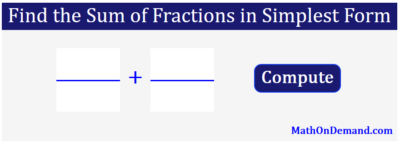Given:
Since the denominators are not common (not the same), we need to find the Least Common Denominator (LCD), which is equivalent to the Least Common Multiple of 5 and 9:
LCD = LCM(5, 9) = 45
Express the given fractions as equivalent fractions with respect to the LCD (45):
Since the equivalent fractions have common denominators, we can add the numerators:
4/9
+ 12/15
, which equals 4/9
+ 4/5
(second fraction simplified)Since the denominators are not common (not the same), we need to find the Least Common Denominator (LCD), which is equivalent to the Least Common Multiple of 5 and 9:
LCD = LCM(5, 9) = 45
Express the given fractions as equivalent fractions with respect to the LCD (45):
4/9
= 20/45
and 4/5
= 36/45
As a result, 4/9
+ 4/5
= 20/45
+ 36/45
Since the equivalent fractions have common denominators, we can add the numerators:
20/45
+ 36/45
= 20 + 36/45
= 56/45
56/45
is in Simplest Form since the Greatest Common Factor of 45 and 56 equals 1, GCF(45, 56) = 1Therefore, the Sum of 4/9
and 12/15
is equal to 56/45
in Simplest Form: 4/9
+ 12/15
= 56/45
Note: 56/45
is an improper fraction, and as a mixed number, 56/45
= 111/45

